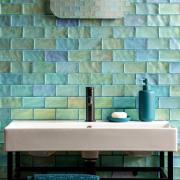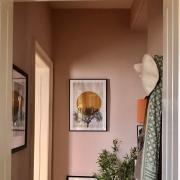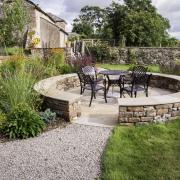It can be easy to assume that sustainable home design means big ticket items such as new boilers and more insulation, A+++ energy rate appliances and investing in renewable energy.
Whilst these are all great solutions if you have the budget and happen to be renovating, replacing appliances or investing in the long term, there are smaller changes you can make in order to up your eco game at home.
Every considered purchase (or not) you make can help to reduce your impact, and every collective little step, can bring about habitual change that makes a dramatic difference.
The first step to creating a sustainable home starts with becoming more mindful about what we buy, where and who we buy it from and what it’s made of; questions and decisions that can make an enormous difference.
Here are six ways to make more sustainable home design choices:

Choosing furniture and decor items made from recycled or reclaimed materials helps stop perfectly usable items from going into landfill as well as reducing the use of virgin materials.
Cork is a wonderfully tactile, natural and sustainable natural materials. It comes from the bark of the cork oak tree and harvesting the bark does not harm the tree. Once a cork tree reaches the age of 25, the bark can be harvested. Cork bark takes around nine years to grow back and in its 200-year lifespan it can yield 16 harvests of raw cork.
Cornwall-based company LIGA is known for its range of cork homewares which includes an innovative range of “beach clean” home accessories made from recycled beach plastics blended with cork.
In my own home I use their plain cork table mats and the thick cork trivets (purchased from Hesta Scene, in Caldbeck) are useful in the kitchen as well as attractive on the dining table.

Incorporating antique and vintage pieces into your home is one way to add instant character as well as authentic texture and patina that you simply can’t buy in a new piece.
I add vintage or antique pieces into every design scheme I create. Not only is it a plant-friendly way to furnish a space, but unique and one-of-a-kind furniture pieces can also add a character, soulful layer to any décor scheme.
Fancy a day trip antiquing? Then head over to Brampton, just a short ride east from Carlisle where you will find a good concentration of antique shops.
Brampton is also home to Lowther Furniture, a family run business which specialises in preloved furniture. The large warehouse has all furniture styles to suit all décor vibes. There is always something new to look at with stock arriving weekly. Be sure you follow on social media to see latest stock drops because it doesn’t last long before it gets snapped up.
The four walls: think about how many internal walls you have in your home. Paint offers an easy and often affordable way to transform any space, so your paint choice can go a long way to creating a greener home while also helping to minimise your indoor air pollution.
Always choose non-toxic paints. Low VOC (volatile organic compounds, which can evaporate at room temperature) content is the legal minimum in the UK. Paint is responsible for 26 million tonnes of VOCs a year so being more mindful of where you spend your money in home décor materials can help reduce this dramatically.
There are paint brands that do more and create organic and zero VOC products.
Right on our doorstep, local brand Lakeland Paints has been producing zero VOC paint for over 35 years. Lakeland Paints produces a paint range which is chemical free, water based and contains no VOCs, solvents or heavy metals.
As we spend more time than ever before in our homes, paint choice is having more impact on our indoor air quality and overall health and wellbeing so choose wisely where you spend your money.

Materials like organic cotton, linen/flax, hemp, bamboo and wool are all kinder to the skin, help regulate temperature and are produced in more environmentally friendly processes than their synthetic alternatives.
Polyester and nylon, for example, are made with petroleum-based materials manufactured using a cocktail of chemicals which take hundreds of years to break down.
Look for these natural fabrics when updating soft furnishings, bed linens and mattresses. I now sleep on a sheep wool mattress with linen or bamboo sheets and I believe it has improved my sleep while regulating my nighttime temperature.
Natural fibre fabrics will not only help reduce toxic chemicals in the home but also fabrics such as linen/flax are known to have antibacterial and antifungal properties that benefit our health. Plus, they can last a lifetime.

My top five toxin filtering plants are:
Spider plants – NASA’s top choice for absorbing benzene, formaldehyde, carbon monoxide and xylene from the air;
Snake plants (mother in law’s tongue) – super effective at absorbing toxins and releasing oxygen and moisture into the air which helps combat airborne allergens like dust and dander, so great for pet owners;
Peace lily – especially effective at removing benzene ( given off by paint and synthetic fibres) and trichloroethylene (given off by lacquer, glue and varnishes);
Areca palms – minimal maintenance, minimal watering yet mighty at removing formaldehyde;
Boston fern – as well as being highly effective at removing formaldehyde, Boston ferns are also efficient at removing airborne germs, bacteria and moulds.

Big businesses that import goods from distant shores not only have large carbon footprints caused by transporting goods over long distances but also use an excess of packaging to get the items here safely in the first place, and most of this packaging is plastic based materials.
Buying local arts and crafts direct from makers or independent retailers also goes a long way towards supporting your local and regional community. For every £1 you spend locally, you are helping to keep 64p in the local economy. Every time you shop, it is a vote for the businesses you want to support, and your vote matters.
Finally, if you are about to undertake a building or home renovation project, don’t forget to check out The Rebuild Site. Based in Carlisle, this charity aims to reduce waste in the construction industry by giving access to affordable building materials for all. Find out more at rebuildsite.co.uk



























